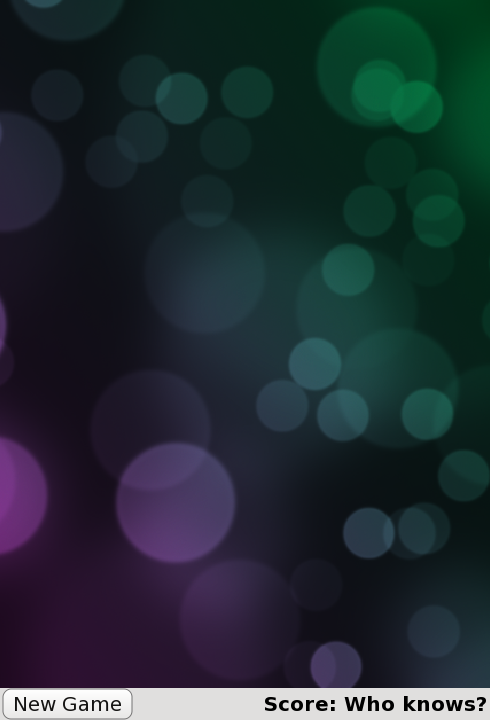The first step is to create the basic QML items in your application.
To begin with, we create our Same Game application with a main screen like this:

This is defined by the main application file,
samegame.qml
, which looks like this:
import QtQuick 2.0 Rectangle { id: screen width: 490; height: 720 SystemPalette { id: activePalette } Item { width: parent.width anchors { top: parent.top; bottom: toolBar.top } Image { id: background anchors.fill: parent source: "pics/background.jpg" fillMode: Image.PreserveAspectCrop } } Rectangle { id: toolBar width: parent.width; height: 30 color: activePalette.window anchors.bottom: screen.bottom Button { anchors { left: parent.left; verticalCenter: parent.verticalCenter } text: "New Game" onClicked: console.log("This doesn't do anything yet...") } Text { id: score anchors { right: parent.right; verticalCenter: parent.verticalCenter } text: "Score: Who knows?" } } }
This gives you a basic game window that includes the main canvas for the blocks, a "New Game" button and a score display.
One item you may not recognize here is the SystemPalette item. This provides access to the Qt system palette and is used to give the button a more native look-and-feel.
Notice the anchors for the
Item
,
Button
and
文本
types are set using group (dot) notation for readability.
Button
and
Block
组件
Button
item in the code above is defined in a separate component file named
Button.qml
. To create a functional button, we use the QML types
Text
and
MouseArea
在
Rectangle
. Here is the
Button.qml
code:
import QtQuick 2.0 Rectangle { id: container property string text: "Button" signal clicked width: buttonLabel.width + 20; height: buttonLabel.height + 5 border { width: 1; color: Qt.darker(activePalette.button) } antialiasing: true radius: 8 // color the button with a gradient gradient: Gradient { GradientStop { position: 0.0 color: { if (mouseArea.pressed) return activePalette.dark else return activePalette.light } } GradientStop { position: 1.0; color: activePalette.button } } MouseArea { id: mouseArea anchors.fill: parent onClicked: container.clicked(); } Text { id: buttonLabel anchors.centerIn: container color: activePalette.buttonText text: container.text } }
This essentially defines a rectangle that contains text and can be clicked. The
MouseArea
has an
onClicked()
handler that is implemented to emit the
clicked()
signal of the
container
when the area is clicked.
In Same Game, the screen is filled with small blocks when the game begins. Each block is just an item that contains an image. The block code is defined in a separate
Block.qml
文件:
import QtQuick 2.0 Item { id: block Image { id: img anchors.fill: parent source: "pics/redStone.png" } }
At the moment, the block doesn't do anything; it is just an image. As the tutorial progresses we will animate and give behaviors to the blocks. We have not added any code yet to create the blocks; we will do this in the next chapter.
We have set the image to be the size of its parent Item using
anchors.fill: parent
. This means that when we dynamically create and resize the block items later on in the tutorial, the image will be scaled automatically to the correct size.
Notice the relative path for the Image type's
source
property. This path is relative to the location of the file that contains the
Image
type. Alternatively, you could set the Image source to an absolute file path or a URL that contains an image.
You should be familiar with the code so far. We have just created some basic types to get started. Next, we will populate the game canvas with some blocks.